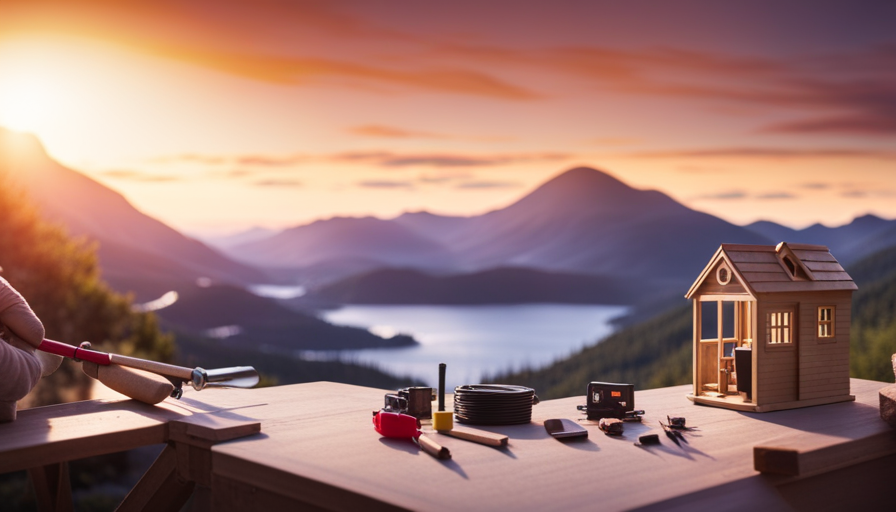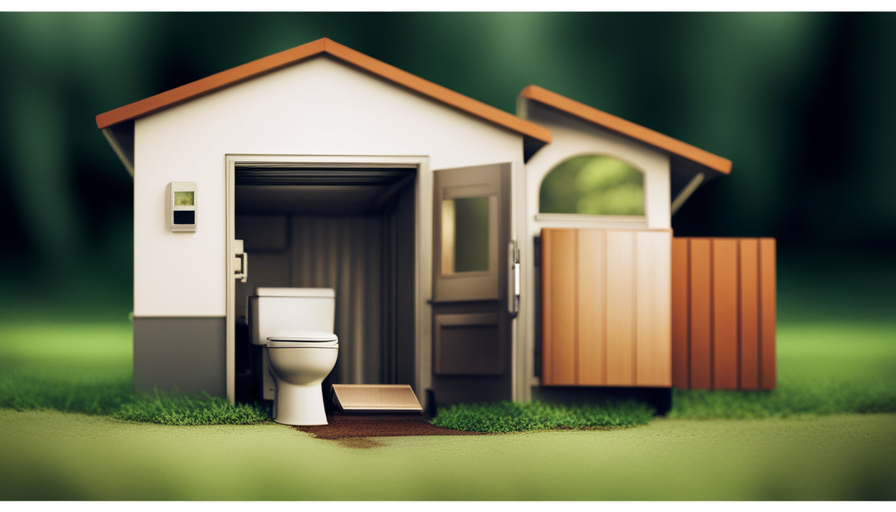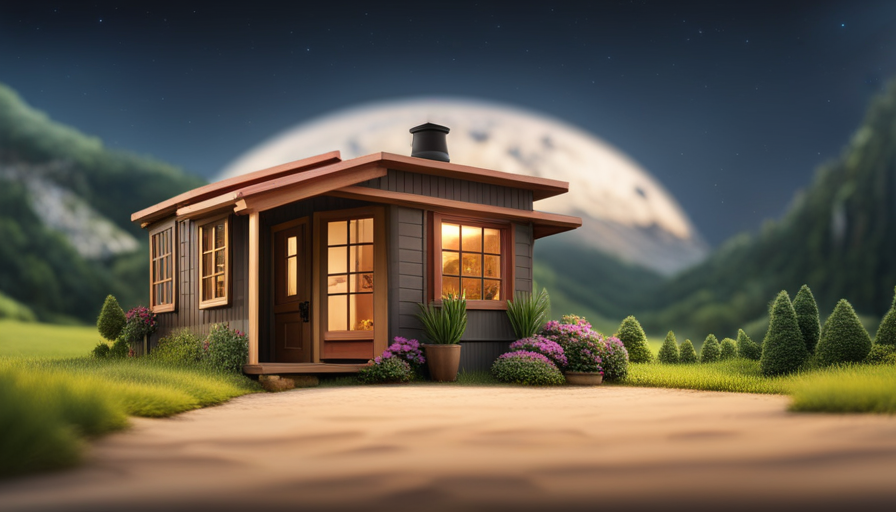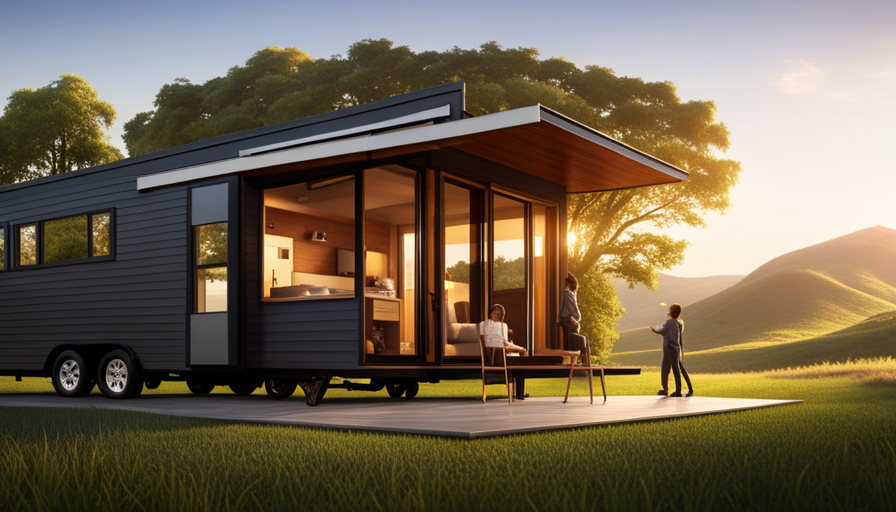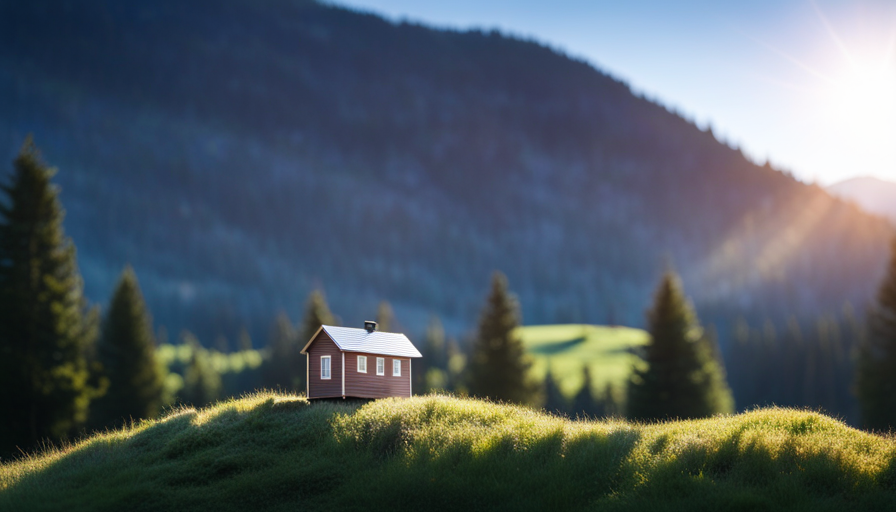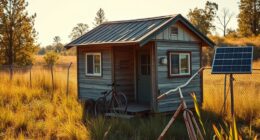In the world of small homes, the significance of size is crucial. As someone who has always been intrigued by minimalist living, I have often wondered about the specific square footage of these cozy dwellings. Today, I am excited to explore this topic and provide a detailed and precise answer.
In this article, we will delve into the world of tiny house living, examining the benefits, challenges, and considerations that come with it. We will define what exactly qualifies as a tiny house and explore the average size of these unique dwellings. Additionally, we will discuss creative storage solutions and offer tips on maximizing space in a tiny house.
Furthermore, we will delve into the fascinating tiny house community and lifestyle, showcasing popular designs and styles that have captured the hearts of many. Finally, we will explore financing and insurance options for those interested in embarking on their own tiny house journey.
Join me as we uncover the world of tiny houses and discover just how much square footage they truly encompass.
Key Takeaways
- Tiny houses range in size from 100 to 400 square feet.
- Tiny houses offer sustainability and cost savings compared to traditional homes.
- Design and layout considerations are important for maximizing space in a tiny house.
- Legal and zoning regulations dictate where and how tiny houses can be built or parked.
Benefits of Tiny House Living
If you’re looking to simplify your life and embrace a more sustainable and cost-effective lifestyle, you’ll love the benefits of living in a tiny house.
Tiny house living offers a unique opportunity to reduce your carbon footprint and live in a more environmentally friendly manner. With a smaller living space, you’ll consume fewer resources and produce less waste, making tiny houses a sustainable housing option.
In addition to their sustainability, tiny houses also offer significant cost savings compared to traditional homes. The smaller size means lower construction and maintenance costs, as well as reduced utility bills. You’ll spend less on heating, cooling, and electricity, allowing you to save money and invest in other areas of your life. Furthermore, the overall cost of purchasing a tiny house is considerably lower than that of a conventional home, making it an affordable housing option for many.
Transitioning to the next section about the definition and criteria for tiny houses, it’s important to understand that the square footage of a tiny house varies. While there is no exact measurement that defines a tiny house, they are typically between 100 and 400 square feet. However, the focus of tiny house living is not solely on square footage, but rather on maximizing functionality and minimizing unnecessary space.
Definition and Criteria for Tiny Houses
When it comes to tiny houses, there are several important factors to consider. First, it’s crucial to understand the square footage requirements for a tiny house. This will vary depending on the specific definition and criteria used, which is often based on the International Residential Code.
Additionally, design and layout considerations play a crucial role in maximizing the use of limited space, while also ensuring functionality and comfort.
Lastly, it’s important to be aware of legal and zoning regulations, as they can vary depending on the location and may dictate where and how you can build or park your tiny house.
Square Footage Requirements
Finding the perfect tiny house is an exciting adventure, especially when you discover just how much space you can create within the limited square footage requirements. When it comes to tiny houses, square footage requirements can vary depending on the specific regulations of the area you are building in. However, many jurisdictions have established guidelines to ensure affordability and sustainability. For instance, some areas may require a minimum square footage of 150 square feet, while others may allow as little as 70 square feet. To provide a visual representation, here is a table showcasing some common square footage requirements for tiny houses:
| Jurisdiction | Minimum Square Footage |
|---|---|
| City A | 150 sq ft |
| City B | 100 sq ft |
| City C | 70 sq ft |
| City D | 120 sq ft |
| City E | 200 sq ft |
Considering these square footage requirements, it becomes evident that tiny houses can be designed and built to fit within various size constraints. Transitioning into the subsequent section about ‘design and layout considerations,’ it is important to understand how these requirements can influence the overall design process.
Design and Layout Considerations
Explore the endless possibilities of creating a personalized and functional living space as you delve into the design and layout considerations of your dream compact dwelling.
When designing a tiny house, it’s crucial to carefully consider every aspect of the layout to optimize the use of space. Design considerations include choosing the right furniture, utilizing built-in storage solutions, and maximizing natural light.
By strategically placing windows, incorporating multi-functional furniture, and using clever storage solutions such as under-bed compartments and wall-mounted shelves, you can make the most out of every square foot.
Additionally, selecting a well-thought-out color palette and using mirrors can create an illusion of a larger space. It’s important to keep in mind that these design choices can significantly impact the overall functionality and livability of your tiny house.
As we move forward into the discussion of legal and zoning regulations, it’s essential to consider these design considerations to ensure compliance with the requirements.
Legal and Zoning Regulations
To create a personalized and functional living space, it’s imperative to familiarize oneself with the legal and zoning regulations governing compact dwellings. When considering the design and layout of a tiny house, it’s essential to understand the legal implications and building codes that apply to these unique structures. Here are some key points to consider:
-
Minimum square footage requirements: Many areas have specific minimum size requirements for dwellings, which may impact the design and layout of a tiny house.
-
Zoning restrictions: Different zoning regulations may limit where a tiny house can be located, such as in designated residential areas or on certain types of land.
-
Accessory dwelling units (ADUs): Some areas allow tiny houses to be used as ADUs, providing additional housing options on existing properties.
-
Safety regulations: Like any other dwelling, tiny houses must adhere to safety regulations, including those related to electrical, plumbing, and fire safety.
-
Permits and inspections: Building a tiny house often requires obtaining permits and undergoing inspections to ensure compliance with local regulations.
Understanding these legal implications and building codes is crucial to ensure that your tiny house is both functional and compliant with the law. Moving forward, let’s explore the average size of tiny houses.
Average Size of Tiny Houses
The average size of tiny houses will surprise you with its cozy and compact charm. While the exact dimensions may vary, tiny houses typically range from 100 to 400 square feet. This compact size allows for a more efficient use of space and encourages a minimalist lifestyle.
Despite their small footprint, tiny houses can still offer all the necessities of a traditional home, including a kitchen, bathroom, living area, and bedroom.
The average size of tiny houses is directly related to the cost analysis of building and maintaining them. With less square footage to cover, the construction costs are significantly lower compared to larger homes. Additionally, the reduced size means less energy consumption and lower utility bills. This cost-effectiveness makes tiny houses an attractive option for those looking to downsize or minimize expenses.
Transitioning into the next section, creative storage solutions are a necessity in tiny houses. Due to limited square footage, it’s essential to maximize every inch of available space. From hidden compartments in furniture to utilizing vertical storage, tiny house owners have mastered the art of organization. These innovative storage solutions allow for a clutter-free living environment and make it possible to comfortably live in a small space without feeling cramped.
Creative Storage Solutions in Tiny Houses
Utilizing inventive storage solutions, tiny homeowners have mastered the art of organization, transforming their compact living spaces into havens of hidden compartments and vertical storage.
When it comes to tiny house organization, space-saving furniture and clever storage ideas are key. Here are three innovative ways tiny homeowners maximize their limited space:
-
Multifunctional Furniture: In tiny houses, every piece of furniture must serve multiple purposes. From sofa beds that double as storage units to coffee tables that convert into dining tables, multifunctional furniture is a game-changer. These ingenious pieces allow homeowners to make the most of their small square footage without sacrificing comfort or style.
-
Vertical Storage: With limited floor space, tiny homeowners turn to the walls for additional storage. Floating shelves, hanging baskets, and wall-mounted hooks are just a few examples of how vertical storage is utilized. By utilizing vertical space, homeowners can keep their belongings organized and easily accessible while keeping the floor clutter-free.
-
Hidden Compartments: Tiny houses are known for their hidden compartments, which provide clever storage solutions. From secret drawers built into staircases to concealed cabinets behind walls, these hidden compartments make use of every nook and cranny. They allow homeowners to maximize their storage capacity while maintaining a clean and uncluttered appearance.
Tiny homeowners have ingeniously incorporated space-saving furniture and creative storage solutions to optimize their tiny living spaces. These innovative ideas allow for efficient organization and a clutter-free environment.
Now, let’s explore some tips for maximizing space in a tiny house.
Tips for Maximizing Space in a Tiny House
When it comes to maximizing space in a tiny house, there are several key points to consider.
First, open floor plans and flexible spaces allow for easy movement and the ability to adapt the layout to fit different needs.
Second, light and bright color schemes can help create the illusion of a larger space and make the interior feel more spacious and inviting.
Lastly, incorporating outdoor living and extending the space beyond the four walls can provide additional areas for relaxation and entertainment.
These tips are essential for making the most out of limited square footage in a tiny house.
Open Floor Plans and Flexible Spaces
With an open floor plan and flexible spaces, a tiny house maximizes every square foot. The absence of walls and defined rooms creates a sense of spaciousness and allows for seamless movement throughout the house. Here are four key features of open floor plans and flexible spaces in tiny houses:
-
Multi-purpose furniture: In a tiny house, every piece of furniture needs to serve multiple functions. For example, a sofa can transform into a bed, and a dining table can double as a workspace.
-
Modular design: The use of modular furniture and fixtures allows for easy customization and rearrangement of the space. Walls and dividers can be added or removed as needed.
-
Storage solutions: Open floor plans often require creative storage solutions. Utilizing vertical space, hidden compartments, and built-in storage helps maximize the available square footage.
-
Natural light: Open floor plans allow for ample natural light to flow throughout the space, making it feel brighter and more airy.
With its open floor plan and flexible spaces, a tiny house sets the stage for the next section on light and bright color schemes.
Light and Bright Color Schemes
After discussing the benefits of open floor plans and flexible spaces in tiny houses, it’s time to move on to another important aspect of these compact homes: light and bright color schemes.
When it comes to small living spaces, lighting options play a crucial role in creating a sense of openness and spaciousness. Natural light is often maximized through large windows and skylights, while artificial lighting is carefully chosen to provide adequate illumination without overpowering the space.
Additionally, minimalist decor is often favored in tiny houses, as it helps to maintain a clean and uncluttered aesthetic. Neutral color palettes with pops of vibrant hues are commonly used to enhance the sense of brightness and airiness in these homes.
Now, let’s explore how outdoor living and the extension of space can be seamlessly integrated into tiny house design.
Outdoor Living and Extension of Space
Create your own oasis in the great outdoors by seamlessly blending the boundaries between your tiny dwelling and the expansive natural world, allowing your living space to spread its wings and take flight like a soaring bird. Imagine enjoying a delightful outdoor dining experience right outside your front door, surrounded by lush greenery and the soothing sounds of nature. With a tiny house, you can have the perfect balance of indoor and outdoor living. Additionally, you can create a small garden right beside your tiny house, providing you with fresh herbs, vegetables, and flowers. Picture yourself tending to your garden, feeling the earth beneath your fingertips and the sun on your face. This extension of space not only enhances your living experience but also connects you to the beauty of the outdoors. As we explore the challenges and considerations of tiny house living, we will delve into the practical aspects of this lifestyle.
Challenges and Considerations of Tiny House Living
Living in a tiny house comes with its own set of challenges and considerations that make the experience unique and rewarding. Here are some of the challenges and benefits that come with tiny house living:
-
Limited Space: One of the biggest challenges of living in a tiny house is the limited square footage. With only a few hundred square feet, every inch counts, and it requires careful planning and organization to make the most of the space available.
-
Simplified Living: While the limited space can be a challenge, it also comes with its benefits. Living in a tiny house forces you to simplify your life and prioritize what’s truly important. It allows you to live with less clutter and focus on experiences rather than possessions.
-
Off-Grid Living: Many tiny house owners choose to live off-grid, which means they aren’t connected to traditional utilities. This can be a challenge as it requires alternative solutions for water, electricity, and waste management. However, it also provides a sense of self-sufficiency and a smaller environmental footprint.
-
Mobility: Tiny houses are often built on wheels, allowing for mobility and the ability to travel. While this can be exciting, it also comes with challenges. Moving a tiny house requires careful planning and consideration of transportation regulations and available parking options.
Living in a tiny house presents its own set of challenges and benefits. Transitioning from the challenges and considerations of tiny house living, let’s explore the vibrant community and unique lifestyle that comes with it.
The Tiny House Community and Lifestyle
What makes the tiny house community and lifestyle so appealing to individuals seeking a more simplified and connected way of living? The tiny house movement has gained popularity in recent years due to its emphasis on minimalist living and a desire to reduce one’s environmental footprint. Tiny house communities have sprung up all over the country, offering a sense of community and shared values among like-minded individuals. These communities often have common spaces, such as gardens or communal kitchens, where residents can come together and build connections. Living in a tiny house also encourages a more intentional and mindful way of living, as space is limited and every item must have a purpose. This lifestyle promotes a sense of freedom from material possessions and encourages individuals to focus on experiences and relationships rather than accumulating stuff.
In exploring the tiny house lifestyle, it’s important to consider various factors such as the size of the tiny house, the location of the community, and the amenities offered. The table below provides a comparison of three popular tiny house communities, highlighting their square footage, location, and amenities:
| Community Name | Square Footage | Location | Amenities |
|---|---|---|---|
| Tiny House Village | 200-400 sq ft | Rural setting | Shared garden, community center |
| Urban Tiny Living | 500-800 sq ft | Urban area | Rooftop terrace, fitness center |
| Eco Village Tiny Homes | 300-600 sq ft | Suburban area | Nature trails, playground |
With an understanding of the tiny house community and lifestyle, let’s now delve into the various popular designs and styles that individuals can choose from to create their own unique tiny home.
Popular Tiny House Designs and Styles
The diverse range of popular designs and styles in the tiny house movement offers a visual feast of unique architectural concepts and creative space-saving solutions. From sleek modern designs to rustic cabins on wheels, there is something to suit every taste and lifestyle.
Here are three popular tiny house designs that have captured the imagination of many:
-
The minimalist design: This style focuses on simplicity and functionality. With clean lines and a clutter-free interior, it maximizes space while providing a sleek and modern aesthetic.
-
The cabin-style design: Inspired by traditional cabins, this design features cozy interiors with wood accents and a rustic charm. It offers a warm and inviting atmosphere, perfect for those seeking a retreat in nature.
-
The eco-friendly design: Sustainability is a key consideration in this design, which incorporates sustainable construction materials and energy-efficient systems. From solar panels to rainwater collection systems, these houses minimize their environmental impact.
As we explore the popular tiny house designs and styles, it’s important to consider financing and insurance options.
Financing and Insurance Options for Tiny Houses
When considering financing and insurance options for a tiny house, it’s important to assess your needs and lifestyle. This involves determining the square footage and amenities that are necessary for your daily life.
Additionally, weighing the pros and cons of owning a tiny house will help you make an informed decision. It’s also beneficial to explore alternative housing options, such as renting or purchasing a traditional home, to ensure that a tiny house is the right choice for you.
Assessing Your Needs and Lifestyle
Consider evaluating your needs and lifestyle to determine the square footage that would best suit you, as studies show that the average tiny house ranges from 100 to 400 square feet. Assessing your needs and lifestyle is crucial in determining the appropriate size for your tiny house. Think about how you will use the space and what activities you will engage in. Will you be working from home? Do you enjoy cooking and entertaining guests? These factors will help you determine the ideal square footage for your tiny house.
To help you visualize the different square footage options, consider the following table:
| Square Footage | Description | Emotion |
|---|---|---|
| 100-200 | Cozy and minimalist | Comfort |
| 200-300 | Functional and efficient | Practical |
| 300-400 | Spacious and versatile | Freedom |
Evaluating your needs and lifestyle will help you make an informed decision about the square footage that aligns with your preferences and requirements. Once you have assessed your needs, you can move on to weighing the pros and cons of tiny house living.
Weighing the Pros and Cons
After carefully assessing my needs and lifestyle, it’s time to weigh the pros and cons of living in a tiny house.
On the one hand, the biggest advantage is the affordability. Tiny houses are significantly cheaper than traditional homes, allowing for a more manageable mortgage or even the option to live debt-free. Additionally, the smaller size means lower utility bills and less maintenance.
On the other hand, there are some drawbacks to consider. Living in a tiny house requires a minimalist mindset and a willingness to downsize belongings. There may also be limited space for hosting guests or expanding a family.
However, one cannot overlook the sustainability aspect of tiny houses. With their smaller ecological footprint and potential for using renewable energy sources, they offer an environmentally friendly lifestyle.
Ultimately, considering the pros and cons of tiny house living, it’s time to explore alternative housing options that may better suit my needs and preferences.
Exploring Alternative Housing Options
To truly embrace a new lifestyle, you must explore alternative housing options that align with your needs and desires. In today’s world, where sustainability and minimalism are becoming increasingly important, alternative housing options offer unique solutions for those seeking a smaller ecological footprint. These options not only provide a smaller living space but also encourage a more sustainable way of life. One such option is a tiny house, which typically ranges from 100 to 400 square feet. However, there are other alternatives worth considering. Below is a table that compares various alternative housing options, highlighting their square footage, cost, and eco-friendliness. By exploring these options, you can find a housing solution that not only meets your needs but also supports sustainable living.
| Housing Option | Square Footage | Cost | Eco-Friendliness |
|---|---|---|---|
| Tiny House | 100-400 sq ft | $30k-$100k | High |
| Shipping Container | 160-320 sq ft | $10k-$50k | Medium |
| RV/Trailer | 100-400 sq ft | $10k-$100k | Low |
| Yurt | 150-700 sq ft | $10k-$50k | High |
Frequently Asked Questions
What are the zoning regulations for tiny houses in different areas?
Zoning regulations for tiny houses vary across different areas. These regulations dictate where and how tiny houses can be built or parked. Some cities have specific zoning codes for tiny houses, while others treat them as accessory dwelling units or recreational vehicles.
It’s important to research and understand the zoning regulations in your desired location before deciding to live in a tiny house. Additionally, there are tiny house communities that provide a supportive environment for tiny house living.
Are tiny houses considered permanent dwellings?
Tiny houses are considered permanent dwellings by some jurisdictions, while others classify them as accessory dwelling units or temporary structures. The legality of tiny houses varies depending on local zoning regulations.
Some areas have specific requirements for minimum square footage, while others have no size restrictions. Additionally, obtaining insurance for a tiny house can be challenging as it often requires specialized coverage.
It’s important to research and comply with local regulations to ensure the legality and insurability of a tiny house.
Can I build my own tiny house or do I need to hire a contractor?
I can definitely build my own tiny house without hiring a contractor. It’s a popular trend among DIY enthusiasts, and there are numerous resources available to guide me through the process.
Building my own tiny house has its pros and cons. On one hand, I have complete control over the design and can save money on labor costs. On the other hand, it requires a significant amount of time, effort, and skill.
How much does it cost to build a tiny house?
The cost of building a tiny house varies depending on several factors. These cost factors include the size of the house, the materials used, and the location.
DIY construction can be more affordable, as it allows for cost savings on labor. However, professional construction may be necessary for those without construction experience.
It’s important to carefully consider these factors and create a budget to determine the overall cost of building a tiny house.
Are there any restrictions on where I can park my tiny house?
Parking restrictions for tiny houses can vary depending on where you live. In some areas, you may encounter limitations on where you can park your tiny house, such as zoning regulations or homeowner association rules. However, there are also tiny house communities popping up across the country that offer designated parking spaces for tiny homes. These communities provide a supportive environment and often have shared amenities, making them a great option for tiny house living.
Conclusion
In conclusion, living in a tiny house offers numerous benefits, from lower costs to a simplified lifestyle. The average size of a tiny house is around 400 square feet, providing just enough space for all your needs.
A fascinating statistic to consider is that the average American home is about 2,600 square feet, meaning you could fit approximately six tiny houses within the same area. This stark contrast highlights the minimalistic nature of tiny house living and the efficient use of space that comes with it.
Hi, I’m Emma. I’m the Editor in Chief of Tiny House 43, a blog all about tiny houses. While tree houses are often associated with childhood, they can be the perfect adult retreat. They offer a cozy space to relax and unwind, surrounded by nature. And since they’re typically built on stilts or raised platforms, they offer stunning views that traditional homes simply can’t match. If you’re looking for a unique and romantic getaway, a tree house tiny house might just be the perfect option.

